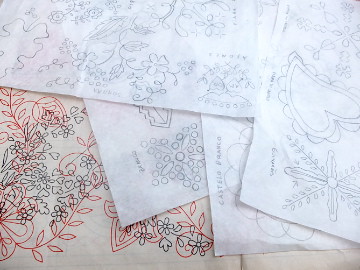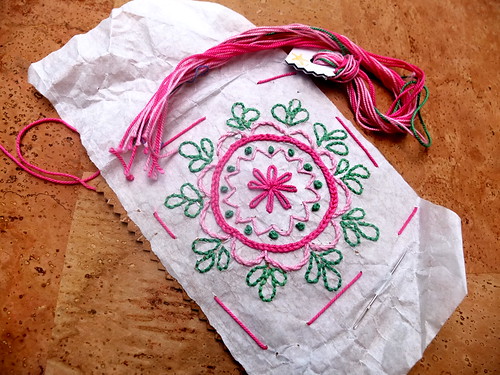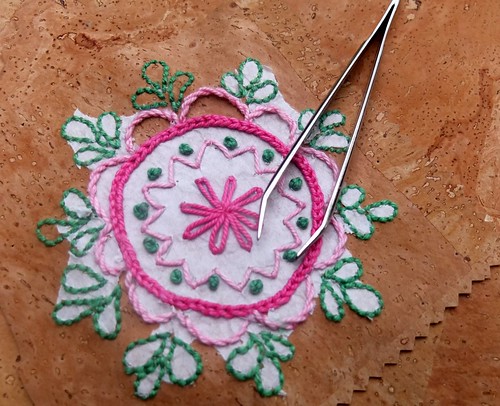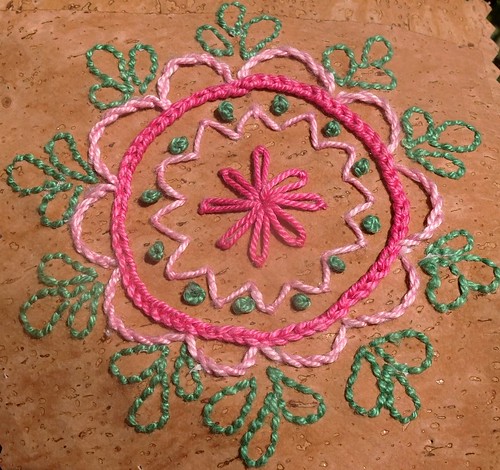 |
| Design sheet and tracing paper, my photo |
Olá! After reviewing the book "Traditional Embroidery of Portugal" I was amazed with the design sheets that were included in it. But believe me... What a big confusion! They are profusely filled with drawings which overlap each other and it becomes very difficult to identify and capture a single pattern. But I managed to do it and after some finishing touches I ended up with four sheets of tracing paper filled of marvelous patterns representing various types of traditional Portuguese embroidery. I'm feeling so rich!!! And I want to share my richness with you...
 |
| Original pattern and embroidery, my photo |
From all the patterns I've traced from the design sheets, I chose one as a gift for you... It's a motif commonly used in Viana do Castelo embroidery. In this photo you can see the design sheet with the pattern and the photo of the piece of embroidery that was pictured in the book. The original embroidery was inspired by colorful wool embroidered traditional costumes of a Northern Portuguese region, "Minho". The pattern belongs to a larger motif and slightly adaptations were made in order to obtain a single pattern.
It's yours... You can download it here. Enjoy it!
After choosing this pattern my research work begun... I knew this was very a common motif in Viana do Castelo embroidery once it is similar to one of the patterns I use in my kits. I needed to fully understand what does it represent. And I already know it!! Let me tell you about it. We owe the beauty of this pattern to the women of the Minho which endowed with a true artistic sense invented the gayest and most decorative skirt bands, pockets and bodice backs. Originally this kind of motifs were wool embroidered and its chief characteristics were the use of metallic thread to outline the motifs, beadwork and satin stitch. The motifs were inspired by nature and by surroundings of the embroiderer. These inspirations were reproduced freely, stylized according to personal taste and were rarely realistic.
 |
| Using tracing paper with cork leather, my photo |
One of the favorite sources of inspiration were parts of plants as well as geometric elements, and the pattern I'm giving you perfectly matches these two.We call these patterns "Japoneira"- the stylization of a flower known as camellia imported from the Orient - it relates to one of the most common species, the Camellia Japonica. I would love to show you those I have in my garden, but it is a winter flower and they are all gone... As you imagine this motif results from a really free stylization process... And we have to be inventive to look at the motif and see there a camellia...
These embroiderers, holding a developed artistic sense, improvise in their compositions and are more worried about being faithful to tradition and creating beautiful and harmonious patterns than to truly represent the reality.
Usually the number of petals can go from 6 to 12 and it may arise finalizing a stem (the one I adapted was like this) or finishing a wide spiral. Some small motifs, arranged around it, as small "balls" and leafs, help enhance this motif. There are variations to the design of Japoneiras, recognizable by the trimming of the petals and the large center. You can browse in this document to find many different "Japoneiras", the document is in Portuguese but the images are great!
 |
| Removing tracing paper with tweezers, my photo |
Usually the number of petals can go from 6 to 12 and it may arise finalizing a stem (the one I adapted was like this) or finishing a wide spiral. Some small motifs, arranged around it, as small "balls" and leafs, help enhance this motif. There are variations to the design of Japoneiras, recognizable by the trimming of the petals and the large center. You can browse in this document to find many different "Japoneiras", the document is in Portuguese but the images are great!
I truly love this pattern and I was thinking what could I do with it... I decided this was the time to try something I've been delaying for a while... Frequently I use cork leather in my craft projects but I had never embroidered it...
The Portuguese word for cork is "cortiça" and "sobreiro" for cork oak tree. Portugal is the number one world cork producer... Did you know? Recently new cork products have been created and cork leather is one of the greatest. I love it and I'm so happy that I tried it... It has some limitations... Satin stitch, the most used stitch in wool Viana do Castelo embroidery, is not appropriate and I had to choose other stitches also used in this kind of embroidery like stem stitch, backstitch, french knots, chain stitch and daisy stitch. Another difficulty is to transfer the motif: I decided, as I usually do, to use tracing paper and embroider through it. If your pattern is not too intricate it will work. Be careful to remove the paper, it's better to use tweezers... So here it is my JAPONEIRA embroidered on cortiça.
 |
| Japoneira embroidered on cork leather, my photo |
Do you like this "japoneira" pattern? Isn't it great to know what's behind traditional patterns? They are full of life... And I hope they gain a new life in your hands... I would love to hear your opinion on this, could you please leave a comment when you download your pattern? Obrigada!

That's very pretty, and it looks lovely on the cork!
ReplyDeleteTão giro!! Como tudo que fazes... :) Tens que me ensinar a fazer estas coisinhas! Beijinhos
ReplyDeleteYes, I love it!!! ;)
ReplyDeleteTão giro!!! Como tudo o que fazes... Tenho que aprender a ser como tu! :) Beijinhos
This is so beautiful, Gabriela!
ReplyDeleteCongratulations on your (hard)work :-)
Wow, I love it against the cork background! Thanks for the download and especially its history. This pattern has now entered my to-stitch queue. I have some lovely crewel wool lying around begging to be put to use, but I may have to make a trip to get more colors. Darn. ;-)
ReplyDeleteThank you Gabi for the free pattern. I am going to start on my embroidery this weekend and I look forward to seeing how you are going to apply your piece of embroidery. The use of cork is very interesting and as usual your 'history lesson' is just great.
ReplyDeleteThank you so much for sharing. Cork? Interesting idea. Kathie L in Allentown
ReplyDeleteLove the embroidery on the cork - and thanks for the free pattern! Enjoyed too reading about the history behind the designs - makes it really special.
ReplyDeleteVoce sempre surpreendendo !!! muito lindo !
ReplyDeleteThank you for the pattern! I will have to think a bit on just the right use for it. I love the cork--I was right, it's the same as used for the notebook cover that my husband brought me back from Portugal. That's how I knew Portugal produced so much cork, too--he told me when he got home!
ReplyDeleteI am loving your posts here, so much really interesting information. Thanks for the pattern, wish I could do it in wool, but allergic, so will have to think on this.
ReplyDeleteThis is so pretty. Thank you very much for sharing it, and the information about it, too. :)
ReplyDeleteI usually don’t post in blogs but your blog forced me to, amazing work.. beautiful !
ReplyDeleteI usually don’t post in blogs but your blog forced me to, amazing work.. beautiful !
ReplyDelete